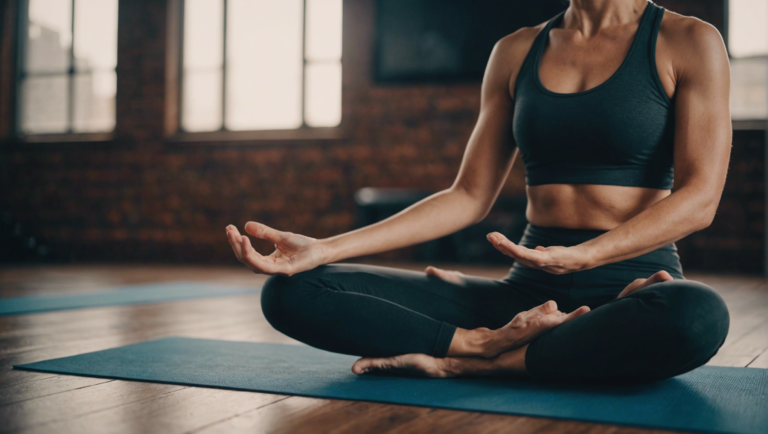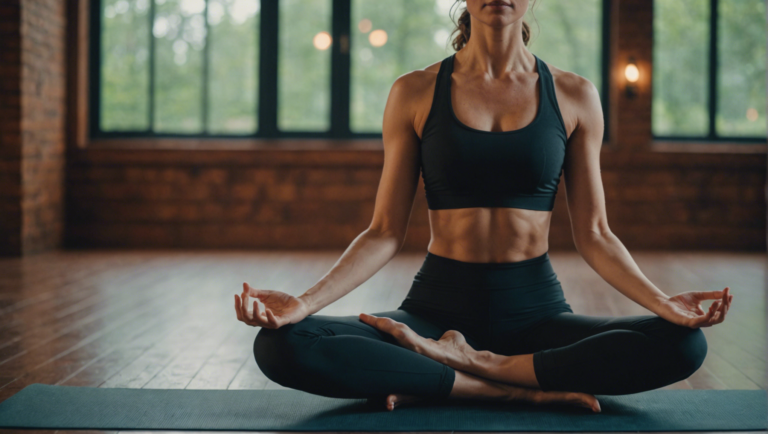Guidelines To Determine What Type Of Yoga Is Best For You
Factors to Consider When Choosing the Best Type of Yoga for Your Needs
Yoga is a versatile and beneficial practice that can help improve physical, mental, and emotional well-being. With various types of yoga available, it can be overwhelming to determine which one is best suited for your needs. Here are some factors to consider when choosing the best type of yoga for you:
Understanding Your Goals and Needs
Before selecting a type of yoga, it is crucial to understand your goals and needs. Are you looking to improve flexibility, reduce stress, build strength, or enhance spiritual awareness? Different types of yoga focus on specific aspects such as physical fitness, relaxation, meditation, or a combination of these. By identifying your objectives, you can narrow down the options to find a practice that aligns with what you want to achieve.
Experience and Fitness Level
Consider your experience with yoga and your current fitness level when choosing a yoga style. Some types of yoga, such as Vinyasa or Ashtanga, are more physically demanding and may not be suitable for beginners or individuals with certain health conditions. Restorative yoga, on the other hand, is gentle and ideal for those looking for a more relaxed practice. Choose a style that matches your experience level to avoid injury and enjoy a fulfilling yoga journey.
Physical Limitations and Health Conditions
If you have any physical limitations or health conditions, it is essential to take these into account when selecting a type of yoga. For example, individuals with back problems may benefit from Iyengar yoga, which emphasizes proper alignment and the use of props for support. Pregnant women might find prenatal yoga classes beneficial for their specific needs. Consult with a healthcare provider or a qualified yoga instructor to determine the most suitable practice for your individual circumstances.
Preferences and Personality
Each type of yoga has its unique characteristics, pace, and focus. Some styles, such as Bikram or Hot yoga, take place in a heated room, while others like Kundalini incorporate chanting and meditation. Consider your preferences and personality traits when choosing a yoga practice. If you enjoy a more structured and vigorous workout, Power yoga might be the right choice for you. Those seeking a more gentle and introspective experience may prefer Yin or Hatha yoga.
Availability of Classes and Instructors
When deciding on the best type of yoga for you, consider the availability of classes and qualified instructors in your area. Attending in-person sessions allows for personalized guidance, corrections, and adjustments to enhance your practice. Research local yoga studios, gyms, or community centers to find out which styles of yoga are offered and whether the instructors have the necessary expertise to support your practice effectively.
Trial and Exploration
Ultimately, the best way to determine which type of yoga is most suitable for you is to try different styles and classes. Many studios offer introductory packages or drop-in sessions that allow you to experience various practices before committing to a particular style. Take advantage of these opportunities to explore different yoga traditions, poses, and techniques. Keep an open mind and listen to your body to discover the practice that resonates with you the most.
Choosing the best type of yoga for your needs involves a thoughtful consideration of your goals, experience level, physical limitations, preferences, and availability of classes. By exploring different styles and consulting with experienced instructors, you can find a yoga practice that not only benefits your physical health but also nourishes your mind and spirit. Remember that yoga is a personal journey, and the most important aspect is to find a practice that brings you joy, balance, and overall well-being.
Popular Types of Yoga and Their Unique Benefits
Yoga is a popular form of exercise that promotes physical strength, flexibility, and mental well-being. There are various types of yoga practices, each with its own unique benefits, catering to different needs and preferences. Understanding the various types of yoga can help you determine which one is best suited for your goals and lifestyle.
Ashtanga Yoga: Strength and Endurance
Ashtanga yoga is a physically demanding practice that follows a specific sequence of postures, synchronizing breath with movement. This type of yoga helps build strength, flexibility, and endurance. Ashtanga yoga is ideal for those looking for a challenging and structured practice that promotes discipline and focus.
Hatha Yoga: Balance and Alignment
Hatha yoga focuses on physical postures (asanas) and breathing techniques (pranayama) to achieve balance between the body and mind. This practice is great for beginners as it provides a gentle introduction to basic yoga poses while emphasizing alignment and mindful breathing. Hatha yoga helps improve flexibility, posture, and overall well-being.
Vinyasa Yoga: Flow and Movement
Vinyasa yoga is a dynamic and flowing practice that links breath with movement. This style of yoga is often referred to as "flow yoga" as it involves smoothly transitioning from one pose to another. Vinyasa yoga helps build heat in the body, increase cardiovascular fitness, and enhance flexibility. It is suitable for those who enjoy movement and seek a more energetic practice.
Bikram Yoga: Detoxification and Sweat
Bikram yoga, also known as hot yoga, consists of a series of 26 postures and two breathing exercises practiced in a room heated to a high temperature. This intense form of yoga promotes detoxification through sweating and helps improve flexibility and strength. Bikram yoga is beneficial for those looking to enhance their physical endurance and release toxins from the body.
Yin Yoga: Relaxation and Deep Stretching
Yin yoga focuses on holding passive poses for an extended period, targeting the connective tissues in the body. This slow-paced practice helps improve flexibility, release tension, and promote relaxation. Yin yoga is suitable for those seeking a meditative and calming practice that complements dynamic and active lifestyles.
Kundalini Yoga: Spiritual Awakening
Kundalini yoga combines dynamic breathing techniques, movement, meditation, and chanting to unlock spiritual energy at the base of the spine. This practice aims to elevate consciousness, awaken inner potential, and promote spiritual growth. Kundalini yoga is ideal for those interested in exploring the spiritual aspects of yoga and connecting with their higher selves.
The practice of yoga offers a diverse range of styles, each with its own emphasis and benefits. Whether you are looking to build strength, increase flexibility, reduce stress, or deepen your spiritual awareness, there is a type of yoga that can support your journey towards holistic well-being. Experimenting with different yoga styles and listening to your body can help you discover the practice that resonates most with you. Embrace the diversity of yoga and find the type that best aligns with your needs and aspirations.
Customizing Your Yoga Practice: Tips for Tailoring Yoga to Your Preferences
Yoga is a highly customizable practice that can be tailored to suit various preferences, needs, and goals. By understanding how to personalize your yoga practice, you can make the most out of your sessions and experience enhanced physical, mental, and emotional well-being. Here are some valuable tips for customizing your yoga practice to align with your preferences.
Assess Your Goals and Intentions
Before customizing your yoga practice, take some time to reflect on your goals and intentions. Determine what you aim to achieve through yoga, whether it’s improved flexibility, stress relief, strength building, spiritual connection, or overall wellness. By clarifying your objectives, you can select the appropriate yoga style and techniques that best support your aspirations.
Explore Different Yoga Styles
There are numerous yoga styles, each with its unique focus and benefits. From the dynamic movements of Vinyasa to the gentle stretches of Hatha and the precise alignment of Iyengar, exploring various styles can help you discover what resonates with you the most. Research different yoga practices, attend classes, and experiment with different styles to find the one that suits your preferences and goals.
Listen to Your Body
One of the key principles of yoga is mindfulness, which involves being fully present in the moment and listening to your body’s signals. Pay attention to how your body responds to different poses, movements, and sequences during your practice. Customize your yoga routine by modifying poses, adjusting intensity, or incorporating props to ensure that you practice safely and comfortably.
Customize Your Practice Schedule
Consistency is key to reaping the benefits of yoga. Customize your practice schedule to align with your lifestyle and preferences. Whether you prefer morning sessions to start your day on a positive note or evening practices to unwind and relax, establish a routine that works best for you. Consider factors such as time of day, duration of sessions, and frequency of practice to create a personalized schedule that you can commit to.
Personalize Your Environment
Creating a conducive environment for your yoga practice can enhance your overall experience. Personalize your practice space by adding elements that inspire and motivate you, such as calming scents, soothing music, candles, or inspiring quotes. Ensure that your practice area is clutter-free, well-ventilated, and conducive to mindfulness and relaxation.
Seek Guidance and Support
If you’re new to yoga or seeking to deepen your practice, consider seeking guidance from experienced instructors, attending workshops, or joining a yoga community. Professional guidance can help you customize your practice effectively, refine your techniques, and progress towards your goals. Additionally, connecting with like-minded individuals can provide support, encouragement, and inspiration on your yoga journey.
Customizing your yoga practice allows you to tailor your experience to meet your specific needs and preferences. By incorporating these tips into your practice, you can create a personalized yoga routine that nurtures your body, mind, and spirit, leading to a more fulfilling and transformative practice. Whether you’re a beginner or an experienced yogi, embracing customization can elevate your practice and bring greater depth and meaning to your yoga journey.
Physical vs. Mental Focus: How Different Types of Yoga Differ in Approach
Overview of Yoga Practices
Yoga is a versatile practice encompassing various styles that cater to different needs and preferences. One fundamental aspect that sets each type of yoga apart is the focus it emphasizes during practice. While some forms of yoga prioritize physical postures and alignment, others delve into the mental and spiritual aspects of the practice. Understanding these distinctions can help practitioners choose a style that aligns with their goals and intentions.
Physical Focus in Yoga
Yoga styles like Ashtanga, Vinyasa, and Power Yoga place a strong emphasis on the physical aspect of the practice. These dynamic and fast-paced forms of yoga involve sequences of poses that flow together, challenging the body’s strength, flexibility, and endurance. Practitioners can expect to build muscle, improve cardiovascular fitness, and enhance overall physical health through consistent practice of these styles.
The physical focus in yoga not only helps individuals tone their bodies but also promotes relaxation and stress relief. Engaging in vigorous physical activity releases endorphins, which are known to elevate mood and reduce feelings of anxiety and depression. Additionally, the emphasis on proper alignment and breathing techniques in physical-focused yoga styles helps practitioners improve their posture and increase body awareness.
Mental Focus in Yoga
Contrary to physical-focused yoga styles, practices like Hatha, Yin, and Kundalini Yoga prioritize the mental and spiritual aspects of the discipline. These styles often involve holding poses for extended periods, focusing on breath work, and integrating meditation and mindfulness techniques into the practice. The primary goal of these yoga forms is to cultivate inner peace, emotional balance, and self-awareness.
The mental focus in yoga encourages practitioners to connect with their inner selves, quiet the mind, and explore the depths of their consciousness. By incorporating elements of meditation and mindfulness, individuals practicing mental-focused yoga styles can develop clarity, concentration, and a sense of tranquility. These practices are particularly beneficial for reducing stress, improving sleep quality, and enhancing overall mental well-being.
Choosing the Right Yoga Style for You
When selecting a yoga style that aligns with your preferences and goals, consider whether you are seeking a more physical workout or a deeper mental and spiritual experience. If your aim is to strengthen your body, increase flexibility, and enjoy a dynamic practice, opt for styles like Vinyasa or Power Yoga. On the other hand, if you are looking to reduce stress, enhance mindfulness, and explore the spiritual aspects of yoga, practices such as Hatha or Kundalini Yoga may be more suitable.
It is essential to remember that yoga is a personal journey, and what works for one individual may not necessarily resonate with another. Experimenting with different styles and teachers can help you discover the type of yoga that best suits your needs and preferences. Whether you gravitate towards the physical intensity of Power Yoga or the introspective nature of Yin Yoga, embracing a consistent yoga practice can lead to holistic well-being and self-discovery.
Assessing Your Goals: Matching Your Yoga Practice to Your Wellness Objectives
Whether you are new to yoga or have been practicing for years, aligning your yoga practice with your wellness goals is essential for achieving optimal physical, mental, and emotional health. To ensure that your yoga practice is in harmony with your wellness objectives, it is important to assess your goals and choose the type of yoga that best suits your needs. By understanding your intentions and objectives, you can tailor your practice to address specific areas of improvement and enhance your overall well-being.
Understanding Your Wellness Objectives for a Personalized Yoga Practice
Before embarking on your yoga journey, take some time to reflect on your wellness objectives. Consider what you aim to achieve through your yoga practice – whether it is to increase flexibility, reduce stress, build strength, improve posture, enhance mindfulness, or find inner peace. By identifying your goals, you can narrow down the types of yoga that are most aligned with what you want to accomplish.
Exploring Different Types of Yoga to Match Your Goals
Yoga is a diverse practice with various styles and approaches, each offering unique benefits and focusing on different aspects of well-being. Some popular types of yoga include Hatha yoga, Vinyasa yoga, Ashtanga yoga, Bikram yoga, Yin yoga, and Restorative yoga, among others. To determine the best type of yoga for you, it is important to explore and understand the characteristics of each style.
Matching Your Wellness Objectives with the Right Yoga Practice
Once you have a clear understanding of your wellness objectives and have explored different types of yoga, you can match your goals with the right yoga practice. If your goal is to build strength and stamina, a dynamic style like Vinyasa or Ashtanga yoga may be suitable for you. On the other hand, if you seek deep relaxation and stress relief, Restorative or Yin yoga might be more beneficial.
Customizing Your Yoga Practice for Optimal Results
It is essential to customize your yoga practice to maximize the benefits and achieve your wellness objectives. Consider incorporating specific poses, sequences, breathing techniques, and meditation practices that align with your goals. Consult with experienced yoga instructors or practitioners to tailor your practice for optimal results and to ensure that you are practicing safely and effectively.
Aligning your yoga practice with your wellness objectives is crucial for creating a personalized and effective routine that caters to your specific needs. By understanding your goals, exploring different types of yoga, and customizing your practice, you can enhance your overall well-being and experience the transformative power of yoga in your life. Embrace the journey of self-discovery and growth through yoga, and let your practice guide you towards a healthier, balanced, and more fulfilling life.
Conclusion
When it comes to determining the best type of yoga for you, it is crucial to consider various factors to ensure that your practice aligns with your needs and goals. By evaluating aspects such as your fitness level, health conditions, preferences, and wellness objectives, you can make an informed decision that enhances both your physical and mental well-being.
Exploring the various types of yoga and understanding their unique benefits can help you tailor your practice to suit your requirements. Whether you prefer the dynamic flow of Vinyasa, the precise alignment of Iyengar, the calming effects of Yin, or the spiritual aspects of Kundalini, there is a style of yoga that can cater to your specific needs and preferences.
Customizing your yoga practice is essential to ensure that it remains engaging and fulfilling. By incorporating elements that resonate with you, such as music, props, meditation, or breathwork, you can personalize your routine to create a meaningful and enjoyable experience that supports your overall well-being.
Different types of yoga vary in their emphasis on physical versus mental aspects, with some styles focusing more on building strength and flexibility, while others prioritize relaxation and stress relief. By understanding these differences, you can choose a practice that aligns with your current state of mind and body, allowing you to reap the maximum benefits from your yoga sessions.
It is also important to assess your goals and match them with your yoga practice to ensure that you are progressing towards your desired outcomes. Whether your objectives include improving flexibility, reducing stress, enhancing mindfulness, or achieving spiritual growth, selecting the right type of yoga can help you work towards accomplishing these goals effectively.
These considerations into your decision-making process can empower you to select the best type of yoga that resonates with your individual needs and preferences. Remember that yoga is a versatile and adaptable practice that can be customized to suit various lifestyles and wellness objectives. By staying open-minded, exploring different styles, and listening to your body, you can create a yoga practice that nurtures your mind, body, and spirit, leading to a more balanced and harmonious life.



